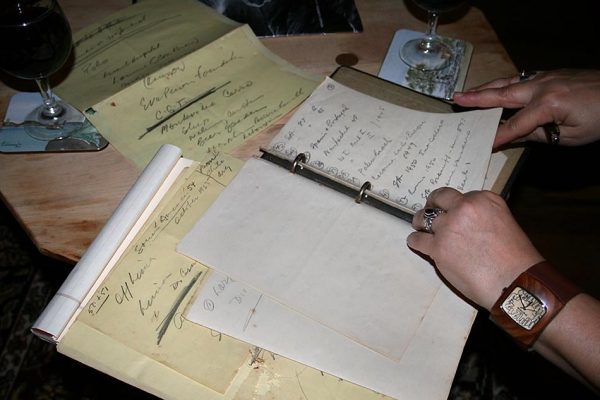
Since I have had the privilege of getting to know Chevalier Jackson’s great-grandchildren, Frank Bugbee, Jr., and Susan Ruby Bugbee, a separate project rich in its implications for the history of nontheatrical film-making and for the history of medicine has come to light: over 60 home movies dating from the 1930s to 1960 that include incomparable footage of Chevalier Jackson, Sr., writing and drawing at his home and workspace at Old Sunrise Mills in Schwenksville, PA; footage of international travel to medical meetings by Chevalier L. Jackson, including color, inter-titled documentation of a trip to 1936 Berlin where the Congress of Otolaryngology met that year; and, rare footage of medical procedures and teaching aids, including, for example, a film titled “Pop Pop and Rag Doll,” in which Chevalier Jackson is shown performing an emergency tracheotomy on a rag doll.
Under the guidance of archivists and preservationists, our hope is to bring the collection into the public domain while also drawing on the memories of physicians, colleagues, and friends of the Chevaliers Jackson who are still living to provide identifying details and context for these films.
The significance of the curious, short film, “Pop Pop and Rag Doll,” cannot be underestimated: as Dr. Paul Castellanos reminds us, Jackson is “the father of modern tracheotomy technique. Without his contribution to this arguably tiny sphere of care, millions would be dead and countless others would never have come to be.” Jackson was one of the first to describe tracheotomic technique in the medical literature (dating to 1909), and his method is still the standard bearer to this day. In one of his many articles on the subject, he suggests that one only need a “knife and pair of hands” to perform the surgery, and that “even eyesight is not essential [since] the author twice has been quite successful in a dark room with nothing but a knife.” In the film, we see Jackson demonstrating what he called “the two-stage finger guided method” over and against the “stab.” He shows himself attempting to “feel for the corrugated wash-board like trachea in the wound.” Jackson explains that one must use the tip of the index finger to find the trachea which cannot be seen because the wound would be full of blood. In a medical setting, needless to say, he would have assistants. This tracheotomy is performed in the front seat of a car.
In a report from The Plymouth County Medical Society that appears in the November 14, 1929 issue of the New England Journal of Medicine documenting a lecture that Chevalier Jackson gave entitled, “Bronchosocopy as an Aid to the Internist and Surgeon in the Diagnosis and Treatment of Diseases of the Lung,” we get a sense of how films like these figured:
“He illustrated his talk with the aid of lantern slides, moving pictures [italics mine] and also chalk talks, drawing some very beautiful pictures illustrating the different points that he was discussing…The moving pictures seemed to be the most interesting part of Dr. Jackson’s lecture because he thereby illustrated the use of the bronchoscope in removing foreign bodies and in inducing respiration where the lungs had collapsed and the passages had been clogged. Illustrations of young children were shown on the operating table with the bronchoscopist and his team at work, without the aid of an anesthetic, where the children after the operation would slide from the operating table and walk quickly away. One of the pictures shown was a little colored boy who was suffering from tuberculosis. A large abscess had formed on the left side. Tracing the source of the trouble, it was found that the boy had swallowed a quarter and it had become lodged in the child’s bronchi and it had been there for five years. Aspiration had been performed and the foreign body located.”
